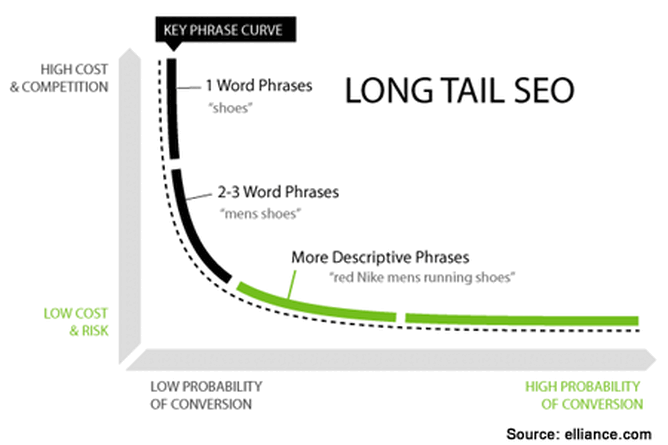Amazon.com just turned 20 years old. That’s right—the Little E-tailer That Could is now officially an adult. After going live on July 16, 1995, Amazon rapidly grew into the king colossus of online retail, and the secret fuelling its two-decade reign could boost your website’s search rankings.
The genius of Amazon, or at least part of it, is that it turns conventional business wisdom on its head. Instead of trying to sell massive amounts of a small number of products, it relies largely on doing the opposite: selling small amounts of a massive number of products. This phenomenon has been dubbed the “long tail” by former Wired editor, Chris Anderson, in his book on the subject: The Long Tail: Why the Future of Business is Selling Less of More. That subtitle is particularly telling. The remarkable success of Amazon teaches us that the real money is often in “selling less of more”.
The long-tail principle applies to search engine optimisation (SEO) too. In other words, rather than trying to have your website rank highly in Google for the most popular search query (related to your industry), it’s often better to aim at ranking highly for other less popular industry-relevant searches.
If you already get the concept of long-tail SEO and just need a few pointers, skip ahead to Part 2 in this blog series to learn how to do it. But if you’re a long-tail greenhorn, read on...
What does the long-tail effect have to do with SEO?
SEO is all about keywords (New to SEO? Learn the basics here). Keywords are the words—usually whole phrases—that your potential customers type into Google and other search engines to find whatever it is you offer. Let’s say you manage an online shoe store. The people you want to attract may type into Google “shoes”, “running shoes” or “women’s mizuno running shoes”. SEO means strategically constructing your website, particularly the copy (i.e., written content), so that it’ll rank highly in the search results whenever somebody types in those keywords.
Keywords can be defined as either “head” (1-2 words) or “long-tail” (3+). These shorter, head keywords are enormously popular; lots of people search for “shoes” or “running shoes”. Long-tail keywords, on the other hand, don’t draw the same kind of attention. The graph below, where the fat end of the curve shows search volume for head and the skinny end for long-tail keywords, makes this pretty clear:
But take another look at that graph. Sure, the long tail isn’t as fat but, as its name suggests, it is long (the x-axis represents all search queries). What does that mean? It means that, while short search queries enjoy the most volume individually, the lion’s share goes to the longer queries collectively. Turns out Spock was right: “the needs of the many outweigh the needs of the few.”
Key numbers about keywords
Thanks to a Google’s nifty keyword tool (more on this below in “How to do long-tail SEO”), we can find out how many people are searching for various keywords. A head keyword, like “shoes”, averages a million searches every month. (Note: For the purposes of this example I’ve removed any geographical parameters.)
That’s a lot of potential shoe customers. Surely you want to target those searchers, right? Not so fast, buddy. Don’t be fooled by all those zeroes. Granted, that is a gigantic number. But there are two problems with going after these sorts of keywords:
- They’re extremely competitive. The high-ranking websites for “shoes” (shoes.com, zappos.com, 6pm.com, etc.) are all well-established sites/companies. The chances of ever outranking the big boys for that search query are almost zilch.
- They’re ambiguous. How many searchers googling “shoes” are actually looking to buy shoes? Some searchers are browsers just “window shopping”, some are kids doing a school project on clothing, some are college students hunting for images for their Powerpoint presentation, some are eggheads trying to settle a dinner-time debate about the ancient origins of shoes, and some are just blogging schmucks like me using shoes as an example.
Phrases of 3+ keywords, like “women’s mizuno running shoes”, yield far fewer. The average monthly number of searches for that search term, even when you include other similar keywords, is well under six thousand.
1,000,000 vs. 6,000. Clearly, your chances of appearing high up in the search rankings for a more specific search query are far greater. Plus, you have much more relevant “user intent”; in other words, you know that a high proportion of those search queries are people actually looking to buy. It’s the old quality-versus-quantity trade-off.
So maybe targeting Holy Grail keywords isn’t such a great idea. Going after those 3-or-more-word queries instead is about drawing quality searchers. Put it this way:
lower competition keywords (long-tail) = higher ranking potential = higher conversion probability
And this, ladies and gentlemen, is long-tail SEO.
The future has a long tail
According to Hittail.com, 70% of all search traffic is in the long tail. On average, souping up your web page for head keywords will see your page jump 5 places up the rankings but for long-tail keywords it’ll climb 11 places. So as you can see, long-tail SEO’s already a big deal—and it’s only getting bigger…
Again, Amazon can teach us something. Their brand new gadget, Echo, is the latest in a recent spate of voice-operated devices and software. And while you may never have used Echo yourself (it was released only in June) you’ve probably used some other more common voice-operated gizmo, like Siri on your iPhone or Google Now on your Google app or Chrome browser. We still often grunt at Siri in cro-magnon monosyllables (“google: ‘shoes’”) but, these days, we’re just as likely to talk to her as if she really is a her i.e., in full sentences or questions (“Where can I buy running shoes?”).
Added to this is the fact that, to quote Jason DeMers at Search Engine Watch, “Google is trying to become a destination for people to get answers.” Instead of simply pointing you towards a website that can answer your query, increasingly Google is providing the answer directly, right there in your search results. Again, this means that we’re moving more and more towards natural language search, using normal sentences as search queries. (Looks like the seemingly gimmicky old search engine, AskJeeves.com, was actually ahead of its time.) When it comes to search queries, long is the new short.
All this to say, that the future has a long tail. Actually, the present has a long tail and the future’s tail is even longer. Now is the time to start playing the long-tail SEO game.
But how do I do long tail SEO? Part 2 has the answer...
Recap
- 70% of search traffic is long-tail.
- There are two advantages to long-tail (3+-word queries):
- Less competitive in terms of search engine ranking
- Less ambiguous in terms of user intent
- Changes in search engine technology is making long-tail increasingly important.




